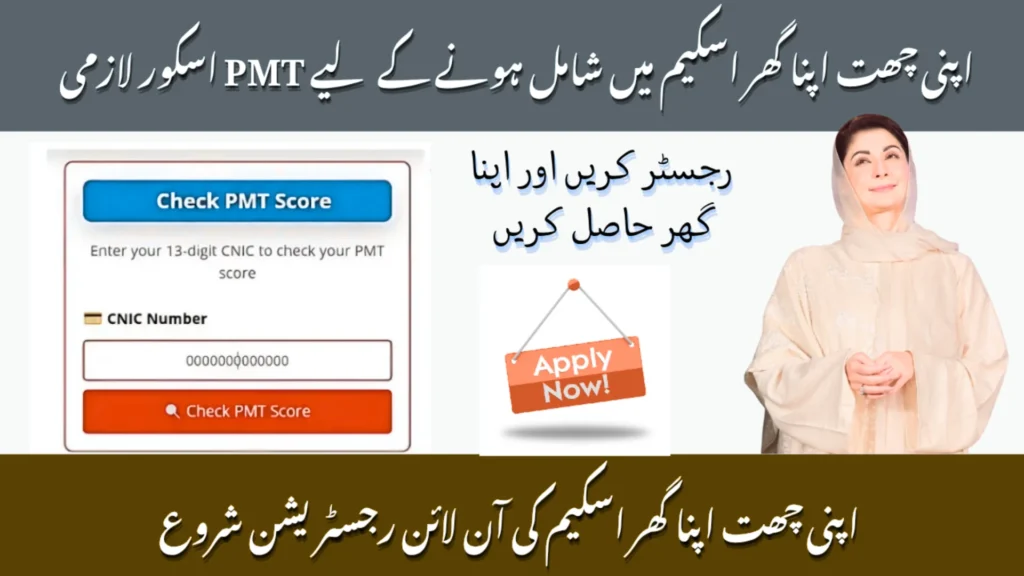
If you’re applying for the Apni Chhat Apna Ghar Scheme 2025 in Punjab, one of the first and most important steps is checking your Proxy Means Test (PMT) score. Launched by the Punjab Housing & Town Planning Agency (PHATA) under the provincial government, this housing-loan programme aims to provide affordable homes to low-income families. The PMT score is used by the Benazir Income Support Programme (BISP) and other bodies to assess how economically vulnerable a household is. According to the official portal, your NSER-registered household must have a PMT score of 60 or less to be eligible.
What Exactly Is the PMT Score?
Your PMT score is essentially a number derived from data about your household, income, assets, living conditions, collected by National Database & Registration Authority (NADRA) and BISP/NSER. It helps determine whether your family qualifies for social-welfare programmes. For the Apni Chhat Apna Ghar scheme:
- The lower your number, the higher your priority.
- The scheme typically regards a PMT score of 40 or less as a strong eligibility indicator.
- Applicants with scores above 40 may get rejected unless specific provincial revisions apply.
By using this PMT filter, the government ensures the support goes to households that genuinely need it and discourages misuse.
Step-by-Step: How to Check Your PMT Score
You can verify your PMT score through two main channels:
Online Method
- Visit the official portal of BISP/NSER or use the scheme’s website. For example: Government of Punjab
- Enter your CNIC number and follow the captcha verification.
- View your PMT score and eligibility status. According to recent sources, a score of 40 or less means you’re in the clear for this scheme.
SMS Method
- Send your CNIC number to the designated number (e.g., 8171) to receive your PMT score via SMS.
- Ensure the mobile number is the one registered with BISP/NSER to avoid “record not found” errors. Some common problems include using a different SIM or having outdated data.
Eligibility Checklist for the Scheme
Before checking your score, make sure you tick other eligibility boxes for the scheme:
- Must be a permanent resident of Punjab, with a valid CNIC.
- Be the head of the family (as defined by NADRA).
- Own or have land not exceeding 5 Marla in urban or 10 Marla in rural areas, on which you intend to build.
- No major criminal conviction or loan default history.
- Registered with NSER and have a PMT score in the approved range.
Table: PMT Score Ranges and Eligibility Status
| PMT Score Range | Eligibility for Scheme |
|---|---|
| 0 – 20 | Highly eligible and top priority. |
| 21 – 40 | Eligible for scheme under normal criteria. |
| Above 40 | Generally not eligible unless revision by government. |
Why This Score Check Step Is Crucial
From experience working with applicants, I’ve seen how this step saves time and frustration. Without the correct score, you may:
- Fill out a full application only to get disqualified later.
- Delay other paperwork (land verification, income proof) before knowing score eligibility.
- Waste effort and resources if your data in NSER/BISP isn’t updated.
Verifying your PMT score first means you enter the scheme confidently, knowing you meet a cornerstone requirement.
Helpful Tips to Make It Smooth
- Use your own CNIC, and ensure it’s the same number registered in BISP/NSER.
- Double-check all digits before pressing submit; one wrong digit may lead to “no match”.
- Keep scanned copies of your CNIC, utility bills, FRC (Family Registration Certificate) ready for upload.
- If your score shows “record not found”, visit the nearest NSER office to update your registration.
- Monitor the scheme’s updates, sometimes the eligible PMT threshold may change, so stay alert.
What Happens After Your Score Check?
Once you confirm your score qualifies:
- Go to the official registration portal of the scheme.
- Fill out your application with correct land, income, biometrics and family details.
- After submission, wait for verification: land-record check, NSER match, and score validation.
- Once approved, you’ll be informed about the loan allotment, model (choice of housing) and next steps.
FAQs
1. What PMT score is required for Apni Chhat Apna Ghar?
A score of 60 or less is generally required according to official eligibility criteria.
2. Is a PMT score of 50 eligible?
Though eligible per “60 or less” rule, many updated sources show that scores of 40 or below are being prioritised.
3. How do I check my PMT score online?
Visit the official portal, enter your CNIC, complete captcha, submit and view your score.
4. Can I check via SMS?
Yes, send your CNIC to the designated number (e.g., 8171) and you’ll get your PMT score via text.
5. What if my score shows “not found”?
You may need to update or register at your nearest NSER office to get your data included.
6. Does being in BISP or Ehsaas help?
Yes, households already registered in BISP/Ehsaas often have validated PMT data and may get priority.
7. What else matters besides PMT score?
Land ownership, lawful CNIC, residency in Punjab, no default loan status, no criminal record.
8. Can someone with a PMT score above 40 apply?
In most cases no, unless a change in policy by the government. It’s best to wait for official updates.
9. Does the scheme cover all districts of Punjab?
Yes, the programme is province-wide managed by PHATA and covers multiple districts with allocated quotas.
10. After passing the score check, when does registration open?
Registration is generally open for most of 2025, but slots are limited; check the official portal regularly.
Conclusion
Checking your PMT score might sound like a small step, but it’s a foundational one for successfully applying to the Apni Chhat Apna Ghar Scheme 2025. If your score falls within the qualifying range and you meet the rest of the criteria, you have a very real chance of securing an affordable home loan, moving from renting to owning. Prepare your documents, verify your status, and take the first step confidently. Best of luck!





